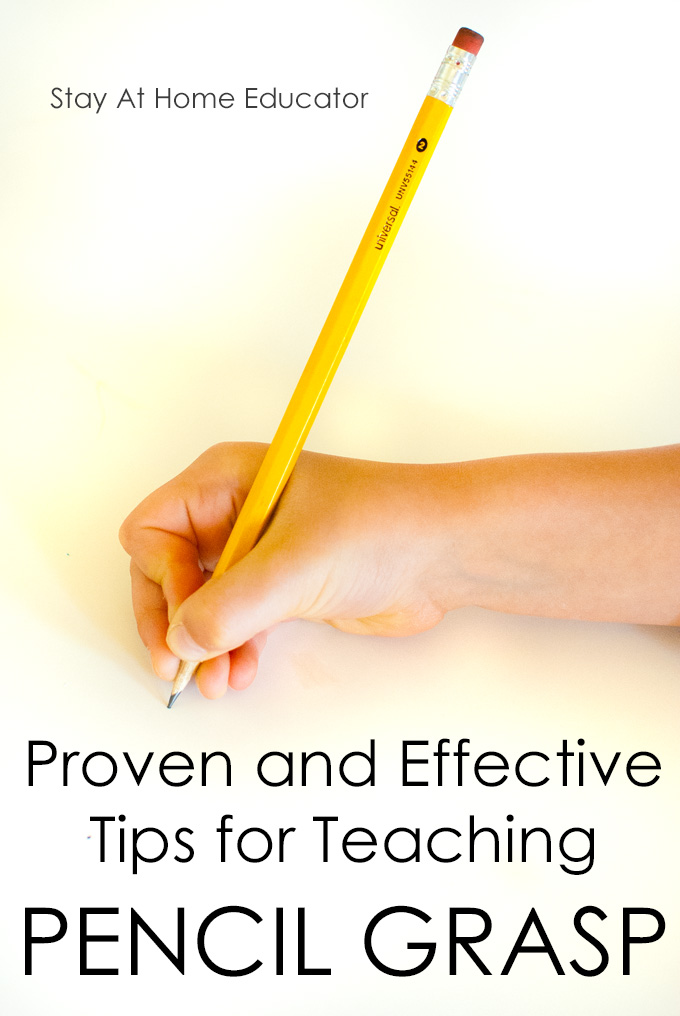Getting a child to use the correct pencil grasp is something that many educators and pediatricians seem to encourage parents to worry about. Reason being is that a correct pencil grip allows children to keep the wrist steady while making the small movements needed for writing and other life skills. Follow these simple tips for teaching pencil grasp to your preschoolers.

Recently, at my son’s yearly check up, the pediatrician (whom I absolutely adore) stated that my son had an immature pencil grip for his age. My son prefers what I call the “death grip”, but what professionals call a palmar grasp. This is where child clutches the pencil with his whole fist, rather than just his fingers.
My pediatrician was right. His pencil grip was considered immature for his age.
So, I set out to find ways to help him develop his pencil grasp.
First, I had to remind myself that using the correct pencil grasp is developmental and it was ok that my three-year-old didn’t have a grasp that looked just like mine. In fact, it’s ok if his grasp doesn’t look exactly like mine when he is four or five-years-old. And, yes, his grasp was more like that of a two-year-old refusing to let go of a lollipop than a mature writer, and that was ok too.
Here’s why.
You see, children go through a predictable sequence of stages when developing their pencil grasp. (More about that in this post).
But, if you are still worried about the development of your child’s pencil grasp, you can try out some of these proven tips.
Proven Tips for Teaching Pencil Grasp
Teaching pencil grasp can be more effective when using the following tips.
Do Lots of Fine Motor Play
And I mean lots! Unless your child is already in formal school, focus when teaching pencil grasp should come primarily in the form of fine motor play. This is because fine motor play develops strength and dexterity of the small muscles of the hand, which are the same muscles used for holding a pencil. Some fine motor activities even mimic the exact grasp needed for correctly holding a pencil. But, since it is presented in the form of play, children are likely to spend more time practicing and will naturally glean more than from paper activities like line tracing.
There are tons and tons of toys that are designed specifically for fine motor practice, too, but it’s easy to encourage fine motor work with basic items from around the house. My kids really enjoy the following toys:
Use Smaller writing Tools
This is a favorite tip among occupational therapists. Use small writing tools like golf pencils, broken crayons, short makers, or small crayon rocks. Using smaller tools means that children cannot use their entire hand to grasp, therefore they must use some form of a pencil grasp, even if it is still slightly immature. Using small writing tools also encourages children to work more deliberately, making smaller, more precise movements similar to those of writing numbers and letters.
Offer a variety of writing tools
Let’s face it. Using a pencil isn’t very fun. It’s not colorful. It makes super thin and light marks. But, a range of markers, crayons, and colored pencils are more appealing to children. I even offer glitter glue pens in my home writing center, Do-a-Dot markers, and even bottles of colored glue. Offering a range of materials will not only keep children interested but any of these listed help strengthen the hands as well as mimic the actual pencil grasp.
The Pom-pom method
Sometimes children have trouble keeping their ring and pinkie fingers tucked into their palm. You can combat this by having your child hold a pom-pom in the palm of their writing hand, using their ring and pinkie fingers to hold it in place. This takes some practice and patience, so if your child is showing signs of frustration, then only practice this method for a few minutes at a time.
Practice Scissor Cutting
Seriously. Scissor cutting skills are really transferable to holding a pencil. In fact, correctly holding and using scissors is very much the same as correctly grasping a pencil. See this post for more information.
Keep it fun
Parents and teachers can sometimes feel pressured to have their children using a mature pencil grasp as soon as possible, but let me remind you that it is a developmental process. When teaching pencil grasp, it’s so important to keep things light-hearted and fun. Children at this age don’t benefit from added pressure, so look for creative ways to develop pencil grasp rather than requiring you child to sit down and trace lines all day. Take a peek a few of my Pinterest boards for ideas.

I’m Sarah, an educator turned stay-at-home-mama of five! I’m the owner and creator of Stay At Home Educator, a website about intentional teaching and purposeful learning in the early childhood years. I’ve taught a range of levels, from preschool to college and a little bit of everything in between. Right now my focus is teaching my children and running a preschool from my home. Credentials include: Bachelors in Art, Masters in Curriculum and Instruction.

Thank you for what you are doing such high quality educational content! Nowadays, it’s really rare. I very much hope that you will continue to do so.
This technique is from Handwriting Without Tears. This company makes these crayons that are double sided. Really neat. All OTs will tell you not to use the fat crayons or a long pencils. Sharpen a child’s pencil to the size you would use to keep golf score. Even up to third grade, you can add your own erasers.
Never have them trace dotted lines. Just from an old teacher.
I was not aware that Handwriting Without Tears uses the same technique. Obviously it works!
I was also going to comment on that! HWT is a wonderful approach to teach correct letter formation and fine motor skills. I have been using this technique with my students (450) in a large preschool and it works excellent!!!
Hi, thank you for sharing, I’ll have to try this, my little girl (I call her that, but actually she is not so little anymore – 10) has been holding her pens and pencils wrong since she started writing. She was seeing an occupational therapist who gave her some exercises to do, but she went back to her old way of writing as soon as we stopped seeing the occupational therapist.
You could break pencils too, if you’re unable to buy small pencils.
Smaller pencils (“golf” pencils) and markers that are shorter and skinnier also work wonders. My kindergarten students love them because they are just the right size.
This works! I first heard about it from my sister when she was teaching Kindergarten. I have tried it with both of my kids and it honestly works wonders. I don’t know what it is about a broken crayon, but for some reason it really encourages correct pencil grip. I’m sharing this on Pinterest so even more people can learn about it! 🙂
It has been my experience that by using a broken crayon, the child doesn’t have the length to hold it incorrectly, thus forcing the use of the pincher grasp.
I just found this on Pinterest, so glad I did. I have a Kindergartner who is a death gripper. I’ll have to try this. I’m glad I found you, you have some great ideas!!
Play with clothes pins. Squeezing them builds pincher muscles as the grip exerciser builds your hands.
Yes! What an excellent suggestion! Thanks for sharing!